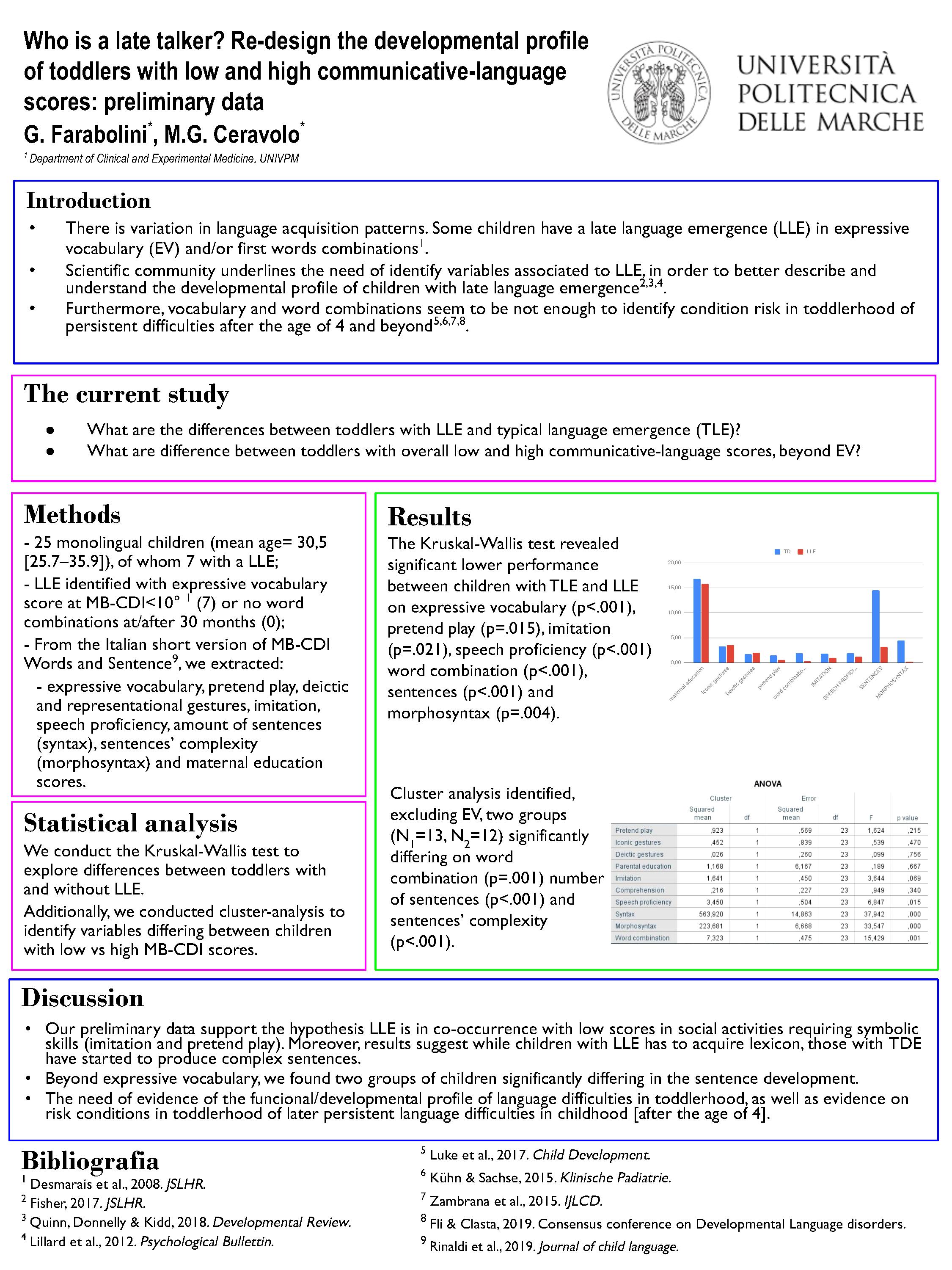Gianmatteo Farabolini - Università Politecnica delle Marche

Who is a late talker?
Re-designing the developmental profile of toddlers with low and high communicative-language scores: preliminary results
Farabolini, M. G. Ceravolo1
1Department of Experimental and Clinical Medicine, Università Politecnica delle Marche
There is variation in language acquisition. Several authors studied the variables most associated with language development1, debating what identifiers (vocabulary and words combination) of late language emergence (LLE) are reliable risk factors of language difficulties2,3,4.
We studied (i) groups’ differences between children with and without a LLE in terms of gestures, pretend play, imitation, intelligibility, comprehension, sentences, complex sentences and parental education (studied variables) scores. Additionally, we explore (ii) differences on the studied variables in toddlers with overall high vs low scores in a language assessment. We recruited 25 Italian parents of as many toddlers (mean age=30.45 months [25.69-35.88]), who completed the Italian MB-CDI5. LLE was identified with an expressive vocabulary score lower than the 10th centile, and/or absence of words combination6 (N=7). From MB-CDI, we extracted data for the studied variables.
We used the non-parametric Kruskal-Wallis Test for research question (i), and cluster analysis for (ii). We found toddlers with LLE have significantly lower scores on pretend play, imitation, intelligibility, sentences and complex sentences (significant variables) than those without LLE (Table 1). We then found the same results using cluster analysis, with the two groups significantly differing on expressive vocabulary, word combinations and the significant variables (Table 2).
Our preliminary results suggest pretend play and imitation seem to be more informative non-linguistic indicators of language development. Expressive vocabulary and words combination are confirmed to be reliable risk factors. We aim to have a larger sample and conduct more detailed cluster analysis.
Word count: 242/250
References
[1] Desmarais, C., Sylvestre, A., Meyer, F., Bairati, I., & Rouleau, N. (2010). Three profiles of language abilities in toddlers with an expressive vocabulary delay: Variations on a theme. Journal of Speech Language and Hearing Research, 53, 699-709.
[2] Fisher, E. L. (2017). A systematic review and meta-analysis of predictors of expressive-language outcomes among late talkers. Journal of Speech, Language, and Hearing Research, 60(10), 2935-2948.
[3] Rescorla, L. (2009). Age 17 Language and Reading Outcomes in Late-Talking Toddlers: Support for a Dimensional Perspective on Language Delay. Journal of Speech, Language, and Hearing Research, 52(1), 16.
[4] Kühn, P., Sachse, S., & von Suchodoletz, W. (2015). Language delay: what is the prognosis of late bloomers?. Klinische Padiatrie, 227(4), 213-218.
[5] Rinaldi, P., Pasqualetti, P., Stefanini, S., Bello, A., & Caselli, M. C. (2019). The Italian words and sentences MB-CDI: Normative data and concordance between complete and short forms. Journal of Child Language, 46(3), 546– 566.
[6] Desmarais, C., Sylvestre, A., Meyer, F., Bairati, I., & Rouleau, N. (2008). Systematic review of the literature on characteristics of late-talking toddlers. International Journal of Language & Communication Disorders, 43(4), 361–389.
